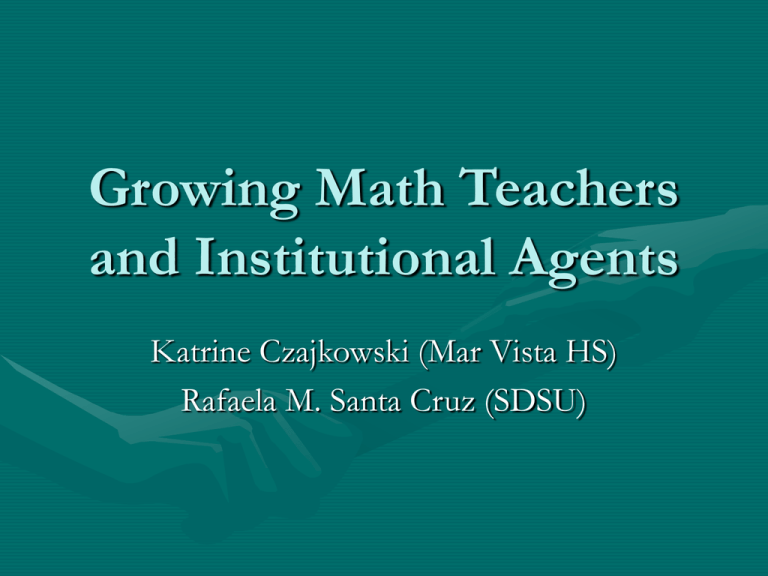Growing Math Teachers and Institutional Agents Katrine Czajkowski (Mar Vista HS)
advertisement

Growing Math Teachers and Institutional Agents Katrine Czajkowski (Mar Vista HS) Rafaela M. Santa Cruz (SDSU) Background: • Will take advantage of relationships developed with mathematics teachers through SDSU professional development projects such as the San Diego Mathematics Project and the Professional Development Collaborative. • Will add to the services provided by various outreach programs such as the SDSU Compact for Success and the College Readiness Program • Will build on SDSU community college transfer programs Objectives: • Increase the number of community college advanced mathematics students who successfully transfer to bachelor’s-granting IHEs, earning degrees in mathematics and science • Develop relationships among successful, diverse community college students and aspiring, diverse high school students • Integrate community college student math tutors within supportive communities of exemplary high school teachers Central components: 1. Recruit diverse community college students currently enrolled in advanced mathematics courses 2. Hire community college students to serve as AVID tutors in high school math classes 3. Train and support tutors to work closely with both students and teachers 4. Support practicing teachers to serve as mentors and role models for classroom tutors 5. Encourage and support tutors’ successful transition to bachelor’s-granting IHEs 6. Maintain long-term relationships with tutors and encourage them to consider pursuing careers as secondary math and science teachers 1. Recruit diverse community college students currently enrolled in advanced mathematics courses Seek students enrolled in Calculus II or more advanced math courses. Visit classes to explain the value of bicultural and bilingual contributions to local schools. Explain mutual benefits of participation with shared goals. Nurture teacher-to-teacher relationships between college and high school instructors 2. Hire community college students to serve as AVID tutors in high school math classes Concentrate placement of tutors at limited sites for maximum coherence and support. Offer competitive pay that does not undercut complementary initiatives. Connect the program to categorical efforts supporting implementation of the Consolidated Site Plan at participating high schools. Assign tutors to work with a specific group of cooperating teachers at each site. Develop, implement and monitor use of a collaborative model maximizing tutor contributions to classrooms. 3. Train and support tutors to work closely with both students and teachers Clearly communicate tutor and teacher roles and expectations. Consider writing “job descriptions.” Build tutors’ work schedules around their college schedules and provide as many hours as requested or possible (10-19/wk). Place tutors in classrooms and after-school programs/services. Recognize initiative and collaboration by providing extra duty pay for teachers and tutors. 3. Train and support tutors to work closely with both students and teachers Introduce tutors to critical measures of external evaluation of students, teachers and schools (API/AYP, CAHSEE, CSTs (and EAP), ELM, etc.) Provide frequent opportunities for tutors to meet and discuss their efforts and related issues (at least monthly). Expose tutors to Math Project workshops and opportunities. Acknowledge, validate, and address the contradictions and conflicts tutors encounter and engage. 4. Support practicing teachers to serve as mentors and role models for classroom tutors Identify teachers with strong content knowledge, pedagogical expertise, concern for equity, and leadership capacity. Build a team (3-4) of these individuals and follow their direction regarding placement of tutors. Assign tutors to these teachers’ classrooms in groups. Provide teachers with training regarding tutor use and instructional strategies maximizing their contributions. Pay teachers for the extra time required to participate. 5. Encourage and support tutors’ successful transition to bachelor’s-granting IHEs Nurture relationships between tutors and teachers. Encourage networking among tutors. Provide opportunities for tutors to lead: curriculum development, instructional activity design, formative assessment of student progress, etc. Match work schedules to college schedules. Provide flexibility when necessary: finals, schedule changes, weekly hour changes, etc. Ensure tutors consistent access to supportive staff at both high school and college levels. 6. Maintain long-term relationships with tutors and encourage them to consider pursuing careers as secondary math and science teachers Invest time in learning about tutors’ lives outside of work. Help tutors with practical issues: transcripts, reference letters, contacts at IHE’s, summer work, etc. Provide varied educational experiences: classroom tutoring, after-school service, professional and curriculum development, extracurricular activities, etc. Celebrate accomplishments: course completions, transfers, graduations, weddings, children, etc.! Summary • Many gifted high school math students do not enroll in four-year schools upon graduation. • Too many successful high school students from marginalized communities leave four-year schools within their first two years. • Motivated community college students may have maturity and life experience that translate to “staying power” needed to become certificated math teachers. • The diversity of community college students mirrors demographics of many CA High Schools. This diversity is painfully lacking among current math teachers in most schools.


